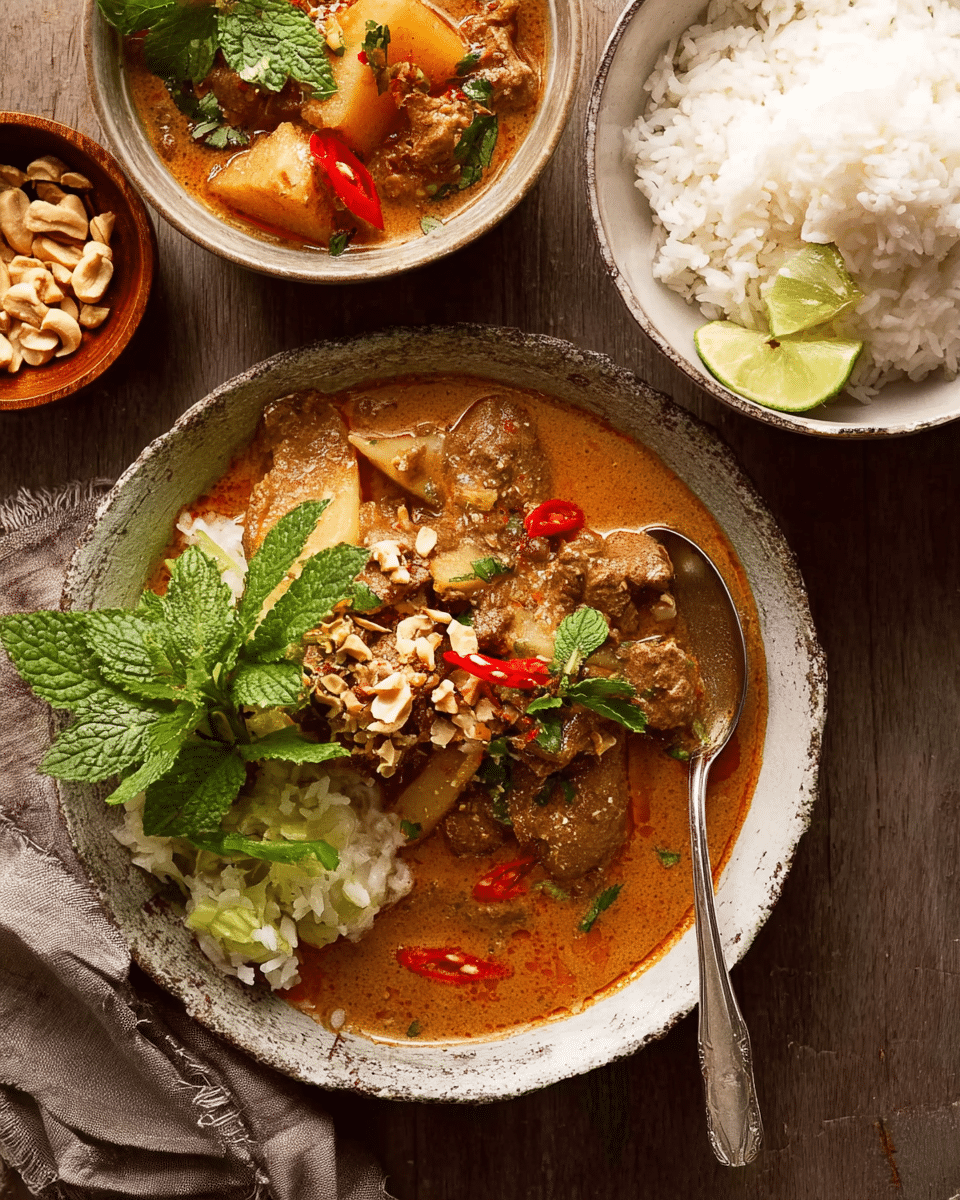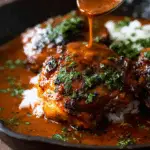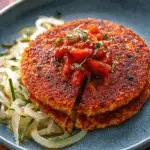This Massaman Curry is an indulgent and comforting dish that perfectly blends the richness of coconut milk with the aromatic spices of Massaman curry paste. The tender beef and potatoes absorb all the bold flavors, making each bite a burst of deliciousness.
This dish is perfect for cozy nights in or dinner parties. The flavor profile can be adjusted to your preference, adding more heat if desired or even substituting the beef for chicken or tofu for a lighter alternative. Garnished with fresh cilantro and roasted peanuts, it’s a true crowd-pleaser.
Full Recipe:
-
500g beef stew chunks
-
1 tablespoon olive oil
-
2 onions, chopped
-
2 cloves garlic, minced
-
1 tablespoon ginger, minced
-
2 tablespoons Massaman curry paste
-
2 tablespoons peanut butter
-
2 cups coconut milk
-
1 tablespoon fish sauce
-
1 tablespoon brown sugar
-
4 medium potatoes, peeled and cubed
-
1 cinnamon stick
-
2 bay leaves
-
1/4 cup roasted peanuts
-
Fresh cilantro for garnish
Directions:
-
Heat olive oil in a large pot over medium-high heat. Add the beef chunks and brown on all sides.
-
Remove the beef and set it aside. In the same pot, sauté onions, garlic, and ginger for about 2-3 minutes, until fragrant.
-
Stir in the Massaman curry paste and peanut butter, cooking for another 2 minutes.
-
Pour in the coconut milk, fish sauce, and brown sugar, then return the beef to the pot.
-
Add the cubed potatoes, cinnamon stick, and bay leaves. Stir to combine and bring the mixture to a boil.
-
Reduce the heat, cover the pot, and simmer for 1-1.5 hours, or until the beef is tender and the potatoes are cooked.
-
Remove the cinnamon stick and bay leaves. Garnish with roasted peanuts and fresh cilantro before serving.
Prep Time: 15 minutes | Cooking Time: 1 hour 30 minutes | Total Time: 1 hour 45 minutes
Kcal: 400 kcal | Servings: 4 servings
Massaman Curry: A Deep Dive into Thai Comfort Food
Massaman curry is one of the most beloved and aromatic dishes in Thai cuisine. It’s a unique and hearty curry that combines rich, coconut-based sauce with tender beef, perfectly balanced spices, and a touch of sweetness. The origins of Massaman curry are somewhat diverse, drawing influences from Indian and Malay cooking, which is why it stands out as a fusion of two distinct culinary traditions. This dish has become a staple in Thai cuisine, frequently featured as a chef’s special in many Thai restaurants, and it’s easy to see why.
The History and Origins of Massaman Curry
Unlike other curries in Thai cuisine, Massaman curry is often seen as an outlier, as it is deeply rooted in Indian and Malay culinary practices. The unique blend of spices such as cumin, coriander, cloves, cardamom, and cinnamon make it distinct from the usual Thai curry paste made with more traditional ingredients like lemongrass, garlic, and galangal. The word “Massaman” itself is believed to derive from “Mussulman,” a term used for Muslims, indicating the dish’s origins with Muslim traders in Thailand, particularly from southern Thailand, which historically had strong trade connections with the Malay and Indian subcontinent.
This curry is a beautiful fusion of the best elements of Indian and Thai cooking – aromatic spices typically used in Indian curries are married with the classic, fresh Thai aromatics. The creamy coconut milk used in the base creates a luxurious, silky texture, while the spices bring warmth and depth to the dish.
Why Massaman Curry is So Special
Massaman curry stands apart from other curries due to its unique blend of flavors and ingredients. The curry’s mild heat is complemented by the sweetness of the coconut milk and the savory flavors of beef or chicken. It’s not as fiery as some other Thai curries, making it more accessible to a broader range of tastes. The curry paste itself, which can be made from scratch or purchased, is an essential component of the dish. It’s made from a variety of fresh and dried ingredients, including garlic, shallots, lemongrass, dried red chilies, and galangal, all of which add complexity and depth to the flavor profile.
The Massaman curry also includes a mix of spices that are not commonly used in other Thai curries, such as cinnamon, cloves, and nutmeg, which give it a rich and warm aroma. The potatoes are a signature addition, absorbing the curry’s sauce and adding a delightful texture. Peanuts, often used as a garnish, further enhance the dish, adding a lovely crunch and a nutty flavor that complements the richness of the curry.
Choosing the Right Meat for Massaman Curry
One of the most important aspects of making a great Massaman curry is selecting the right meat. The traditional choice for this dish is beef, with beef chuck being the preferred cut. The reason for choosing beef chuck is its perfect balance of fat and muscle, which results in tender, juicy chunks of meat when slow-cooked. This particular cut of beef breaks down nicely during the long simmering process, absorbing all the flavors of the curry.
While beef is the most common meat used, Massaman curry can easily be adapted to include other proteins, such as lamb, chicken, or even pork. The key to a successful Massaman curry, regardless of the meat, is to use a cut that can withstand long, slow cooking, allowing the meat to become tender and infused with the rich flavors of the curry.
The Role of Aromatics and Spices
A key feature that sets Massaman curry apart from other Thai curries is its complex and aromatic blend of spices. In addition to the usual Thai curry ingredients such as lemongrass and garlic, Massaman curry also includes more traditional Indian spices like cumin, cinnamon, cardamom, and cloves. These spices provide warmth and depth, contributing to the unique flavor of the curry.
The use of galangal is another distinguishing feature of Massaman curry. Often described as a citrusy, piney version of ginger, galangal adds a distinctive, aromatic flavor that elevates the curry’s depth. Dried Asian chilies are also used, but in moderation, to give the curry just a hint of heat rather than the fiery spiciness found in other Thai curries.
The method of preparing these aromatics is crucial to the dish’s success. The galangal, garlic, and dried chilies are charred in a dry skillet before being processed into a paste. This step imparts a smoky, slightly caramelized flavor to the aromatics, which becomes one of the signature characteristics of Massaman curry.
The Magic of the Curry Paste
The curry paste is arguably the most important part of making Massaman curry. While it’s possible to use store-bought curry paste, making it from scratch offers a deeper and more complex flavor that takes this dish to the next level. The process involves toasting spices such as cumin, coriander, and cardamom in a dry pan, before combining them with the charred aromatics to create a fragrant, flavorful paste.
The homemade paste contributes to the richness of the curry sauce, which is then cooked with coconut milk, potatoes, and braised beef. For those who don’t have the time or inclination to make the paste from scratch, a high-quality store-bought Massaman curry paste can be used as a shortcut. However, it’s important to toast the paste in the pan and add fresh garlic, ginger, and lemongrass to bring out the full potential of the store-bought paste.
Cooking Massaman Curry
The process of making Massaman curry involves a few different stages, but it is not particularly difficult. First, the beef is braised in a broth with lemongrass and bay leaves until it is fall-apart tender. This step imparts a subtle flavor to the meat and creates a rich base for the curry sauce. After the beef is tender, the curry paste is sautéed in oil to release its flavors, before coconut milk, cinnamon, star anise, and the braising liquid are added to form the curry sauce.
The potatoes are added raw and cooked in the curry sauce, soaking up the flavors as they soften. Once the potatoes are tender, the beef is added back into the pot, where it heats through and absorbs the sauce. The key is to taste the curry as it cooks and adjust the seasoning with fish sauce, tamarind, and sugar to balance the flavors of sweet, salty, and sour.
Serving and Garnishing Massaman Curry
Massaman curry is traditionally served over jasmine rice, which complements the richness of the curry. The rice soaks up the sauce, making each bite even more delicious. For added texture and flavor, the curry is often garnished with roasted peanuts, which add a crunchy contrast to the tender meat and potatoes. Some people also like to sprinkle crispy fried shallots and fresh red chilies on top for an extra layer of flavor.
Conclusion
Massaman curry is an exquisite Thai dish that’s rich in history and flavor. With its fusion of Indian and Thai ingredients, this curry offers a unique and unforgettable taste. Whether made from scratch or with a store-bought paste, it’s a dish worth taking the time to prepare. The slow-cooked beef, tender potatoes, and fragrant curry sauce create a dish that is both comforting and sophisticated, perfect for a special dinner or a cozy family meal. By following the steps in this recipe, you’ll be able to bring a taste of Thailand into your kitchen and enjoy a truly authentic Massaman curry that will impress everyone at the table.






